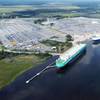Retail Container Traffic Up in March
Cargo volume at the nation’s major retail container ports will be up in March over February as traffic begins its annual climb toward peak season, but volume for the first half of 2009 is still expected to remain well below last year’s levels, according to the monthly Port Tracker report released March 6 by the National Retail Federation and IHS Global Insight.
“February is traditionally the slowest month of the year, so we’re now at the point where we’ll see a gradual increase in volume as retailers bring in spring and summer merchandise and build up toward the holiday season,” NRF Vice President for Supply Chain and Customs Policy Jonathan Gold said. “But this year’s numbers are going to remain well below last year because sales are still slow and most economists aren’t seeing a recovery before the second half of the year at the earliest. Careful inventory management is a key to survival for retailers in the economic times we’re going through.”
U.S. ports surveyed handled 1.05 million Twenty-Foot-Equivalent Units in January, the most recent month for which actual numbers are available. That was down half a percent from December and 14.6 percent from January 2008, making January the 19th month in a row to see a year-over-year decline. The last year-over-year increase was July 2007, when the 1.44 million TEU was up 3.4 percent from July 2006. One TEU is one 20 ft container or its equivalent.
February, traditionally the slowest month of the year, was estimated at 1 million TEU, down 17.7 percent from 2008. March is forecast at 1.07 million TEU, up 5.3 percent from February but down 7.4 percent from a year earlier. April is forecast at 1.14 million TEU, down 10.3 percent from a year ago; May at 1.16 million TEU, down 11.4 percent; June at 1.19 million TEU, down 8.6 percent; and July at 1.21 million TEU, down 7.5 percent.
The first half of 2009 remains forecast at 6.6 million TEU, down 11.7 percent from the 7.5 million TEU seen in 2008. Total volume for 2008 was 15.2 million TEU, down 7.9 percent from 2007’s 16.5 million TEU and the lowest level since 2004’s 14 million TEU.
“The good news is that low volume has left the ports with an excess of capacity that means the cargo coming through is moving without congestion from the harbor to the gate,” IHS Global Insight Economist Paul Bingham said. “Dockside labor, trucks and intermodal rail are all readily available.”
All U.S. ports covered by Port Tracker – Los Angeles/Long Beach, Oakland, Seattle and Tacoma on the West Coast; New York/New Jersey, Hampton Roads, Charleston and Savannah on the East Coast, and Houston on the Gulf Coast – are rated “low” for congestion, the same as last month.
Port Tracker, which is produced by the economic research, forecasting and analysis firm IHS Global Insight for NRF, looks at inbound container volume, the availability of trucks and railroad cars to move cargo out of the ports, labor conditions and other factors that affect cargo movement and congestion. The report is free to NRF retail members. Subscription information is available at: www.nrf.com/PortTracker










